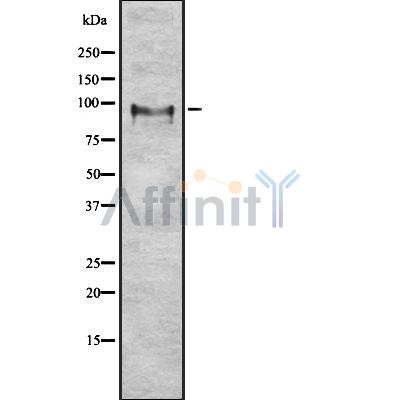ATG9A Antibody - #DF8034
| Product: | ATG9A Antibody |
| Catalog: | DF8034 |
| Description: | Rabbit polyclonal antibody to ATG9A |
| Application: | WB IHC IF/ICC |
| Reactivity: | Human, Mouse, Rat |
| Prediction: | Pig, Bovine, Horse, Sheep, Rabbit, Dog, Chicken |
| Mol.Wt.: | 94 kDa; 94kD(Calculated). |
| Uniprot: | Q7Z3C6 |
| RRID: | AB_2841402 |
Related Downloads
Protocols
Product Info
*The optimal dilutions should be determined by the end user. For optimal experimental results, antibody reuse is not recommended.
*Tips:
WB: For western blot detection of denatured protein samples. IHC: For immunohistochemical detection of paraffin sections (IHC-p) or frozen sections (IHC-f) of tissue samples. IF/ICC: For immunofluorescence detection of cell samples. ELISA(peptide): For ELISA detection of antigenic peptide.
Cite Format: Affinity Biosciences Cat# DF8034, RRID:AB_2841402.
Fold/Unfold
APG9 autophagy 9-like 1; APG9 like 1; APG9-like 1; APG9L1; ATG9; ATG9 autophagy related 9 homolog A; ATG9 autophagy related 9 homolog A (S. cerevisiae); ATG9A; ATG9A_HUMAN; Autophagy 9-like 1 protein; Autophagy related 9A; Autophagy related protein 9A; Autophagy-related protein 9A; mATG9; MGD3208; OTTHUMP00000206046; OTTHUMP00000206048; OTTHUMP00000206049; OTTHUMP00000206062;
Immunogens
A synthesized peptide derived from human ATG9A, corresponding to a region within the internal amino acids.
- Q7Z3C6 ATG9A_HUMAN:
- Protein BLAST With
- NCBI/
- ExPASy/
- Uniprot
MAQFDTEYQRLEASYSDSPPGEEDLLVHVAEGSKSPWHHIENLDLFFSRVYNLHQKNGFTCMLIGEIFELMQFLFVVAFTTFLVSCVDYDILFANKMVNHSLHPTEPVKVTLPDAFLPAQVCSARIQENGSLITILVIAGVFWIHRLIKFIYNICCYWEIHSFYLHALRIPMSALPYCTWQEVQARIVQTQKEHQICIHKRELTELDIYHRILRFQNYMVALVNKSLLPLRFRLPGLGEAVFFTRGLKYNFELILFWGPGSLFLNEWSLKAEYKRGGQRLELAQRLSNRILWIGIANFLLCPLILIWQILYAFFSYAEVLKREPGALGARCWSLYGRCYLRHFNELEHELQSRLNRGYKPASKYMNCFLSPLLTLLAKNGAFFAGSILAVLIALTIYDEDVLAVEHVLTTVTLLGVTVTVCRSFIPDQHMVFCPEQLLRVILAHIHYMPDHWQGNAHRSQTRDEFAQLFQYKAVFILEELLSPIVTPLILIFCLRPRALEIIDFFRNFTVEVVGVGDTCSFAQMDVRQHGHPQWLSAGQTEASVYQQAEDGKTELSLMHFAITNPGWQPPRESTAFLGFLKEQVQRDGAAASLAQGGLLPENALFTSIQSLQSESEPLSLIANVVAGSSCRGPPLPRDLQGSRHRAEVASALRSFSPLQPGQAPTGRAHSTMTGSGVDARTASSGSSVWEGQLQSLVLSEYASTEMSLHALYMHQLHKQQAQAEPERHVWHRRESDESGESAPDEGGEGARAPQSIPRSASYPCAAPRPGAPETTALHGGFQRRYGGITDPGTVPRVPSHFSRLPLGGWAEDGQSASRHPEPVPEEGSEDELPPQVHKV
Predictions
Score>80(red) has high confidence and is suggested to be used for WB detection. *The prediction model is mainly based on the alignment of immunogen sequences, the results are for reference only, not as the basis of quality assurance.
High(score>80) Medium(80>score>50) Low(score<50) No confidence
Research Backgrounds
Involved in autophagy and cytoplasm to vacuole transport (Cvt) vesicle formation. Plays a key role in the organization of the preautophagosomal structure/phagophore assembly site (PAS), the nucleating site for formation of the sequestering vesicle. Cycles between a juxta-nuclear trans-Golgi network compartment and late endosomes. Nutrient starvation induces accumulation on autophagosomes. Starvation-dependent trafficking requires ULK1, ATG13 and SUPT20H.
Cytoplasmic vesicle>Autophagosome membrane>Multi-pass membrane protein. Golgi apparatus>trans-Golgi network membrane>Multi-pass membrane protein. Late endosome membrane>Multi-pass membrane protein. Endoplasmic reticulum membrane>Multi-pass membrane protein.
Note: Under amino acid starvation or rapamycin treatment, redistributes from a juxtanuclear clustered pool to a dispersed peripheral cytosolic pool. The starvation-induced redistribution depends on ULK1, ATG13, as well as SH3GLB1.
Belongs to the ATG9 family.
Research Fields
· Cellular Processes > Transport and catabolism > Autophagy - other. (View pathway)
· Cellular Processes > Transport and catabolism > Autophagy - animal. (View pathway)
Restrictive clause
Affinity Biosciences tests all products strictly. Citations are provided as a resource for additional applications that have not been validated by Affinity Biosciences. Please choose the appropriate format for each application and consult Materials and Methods sections for additional details about the use of any product in these publications.
For Research Use Only.
Not for use in diagnostic or therapeutic procedures. Not for resale. Not for distribution without written consent. Affinity Biosciences will not be held responsible for patent infringement or other violations that may occur with the use of our products. Affinity Biosciences, Affinity Biosciences Logo and all other trademarks are the property of Affinity Biosciences LTD.







